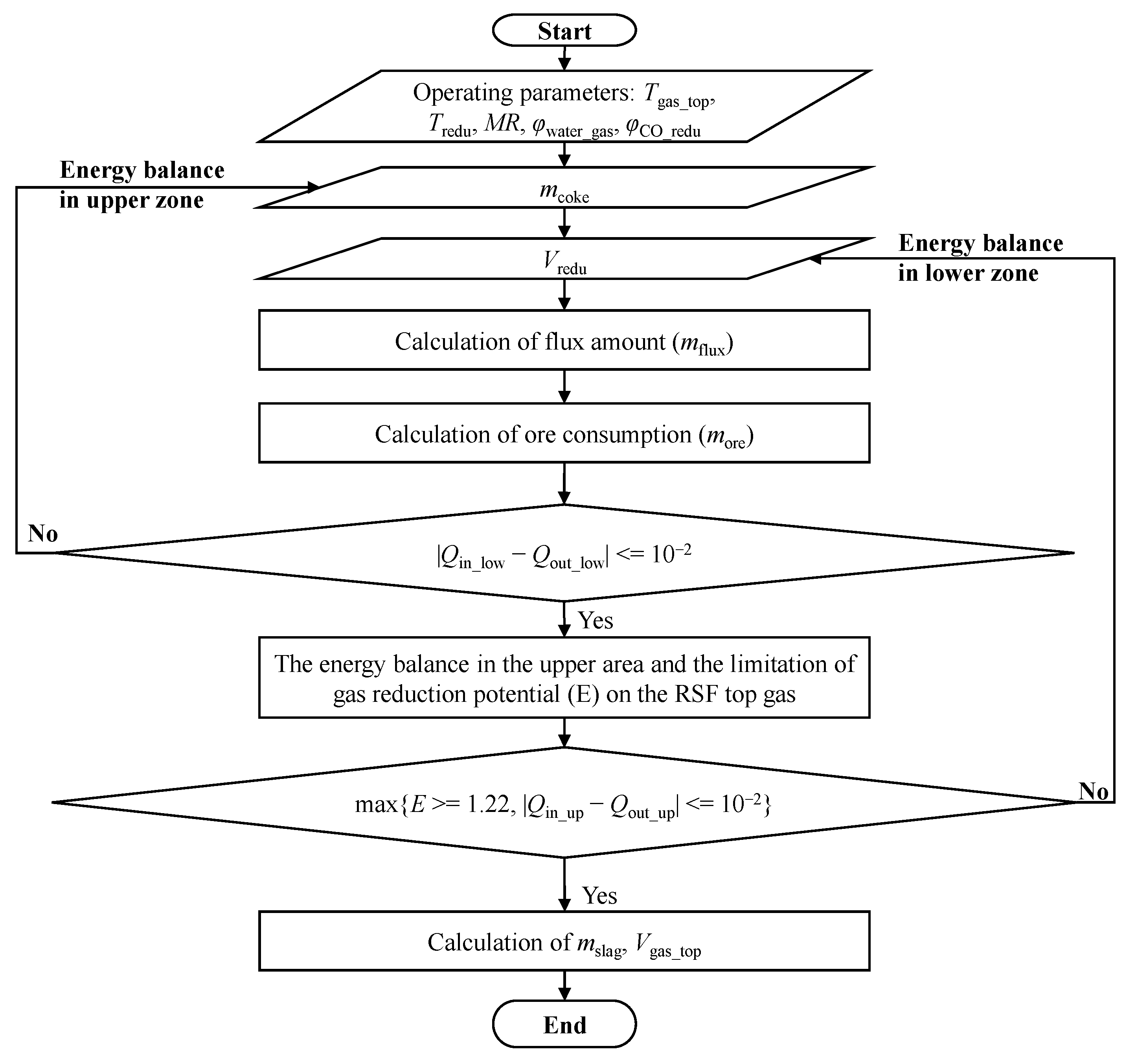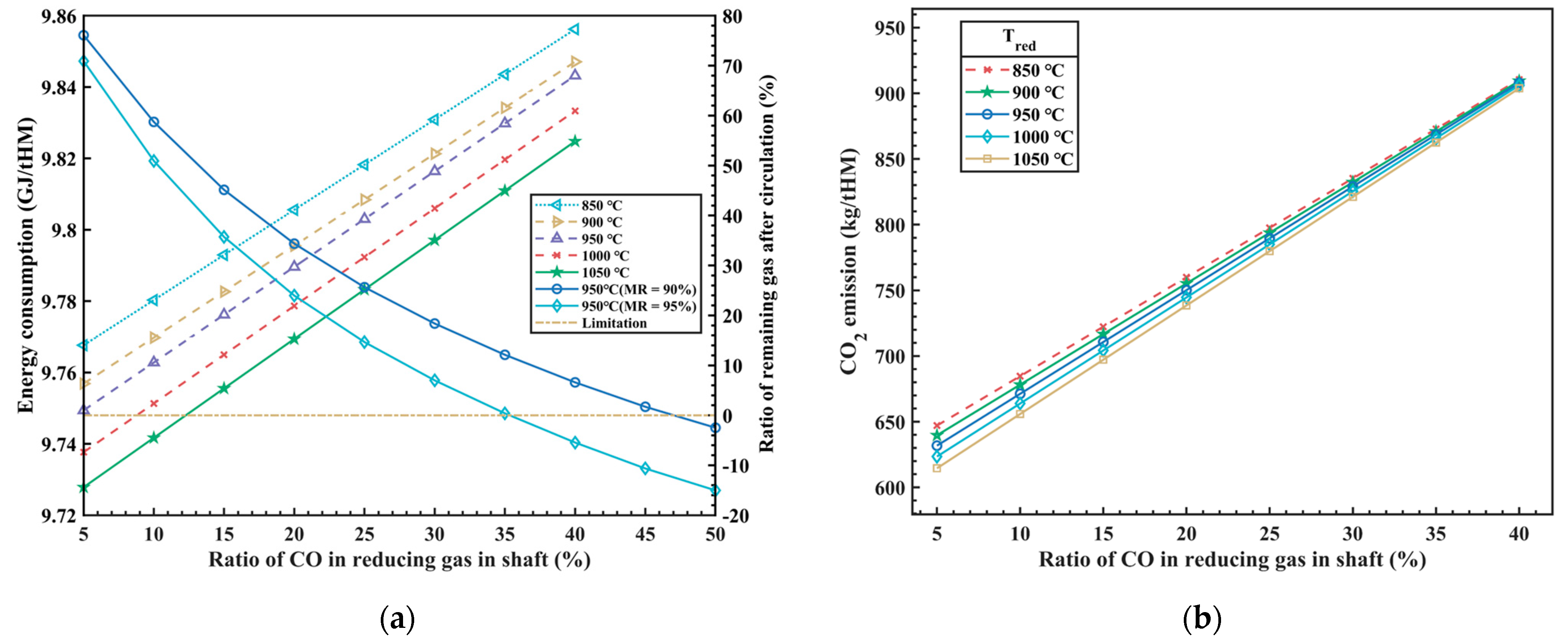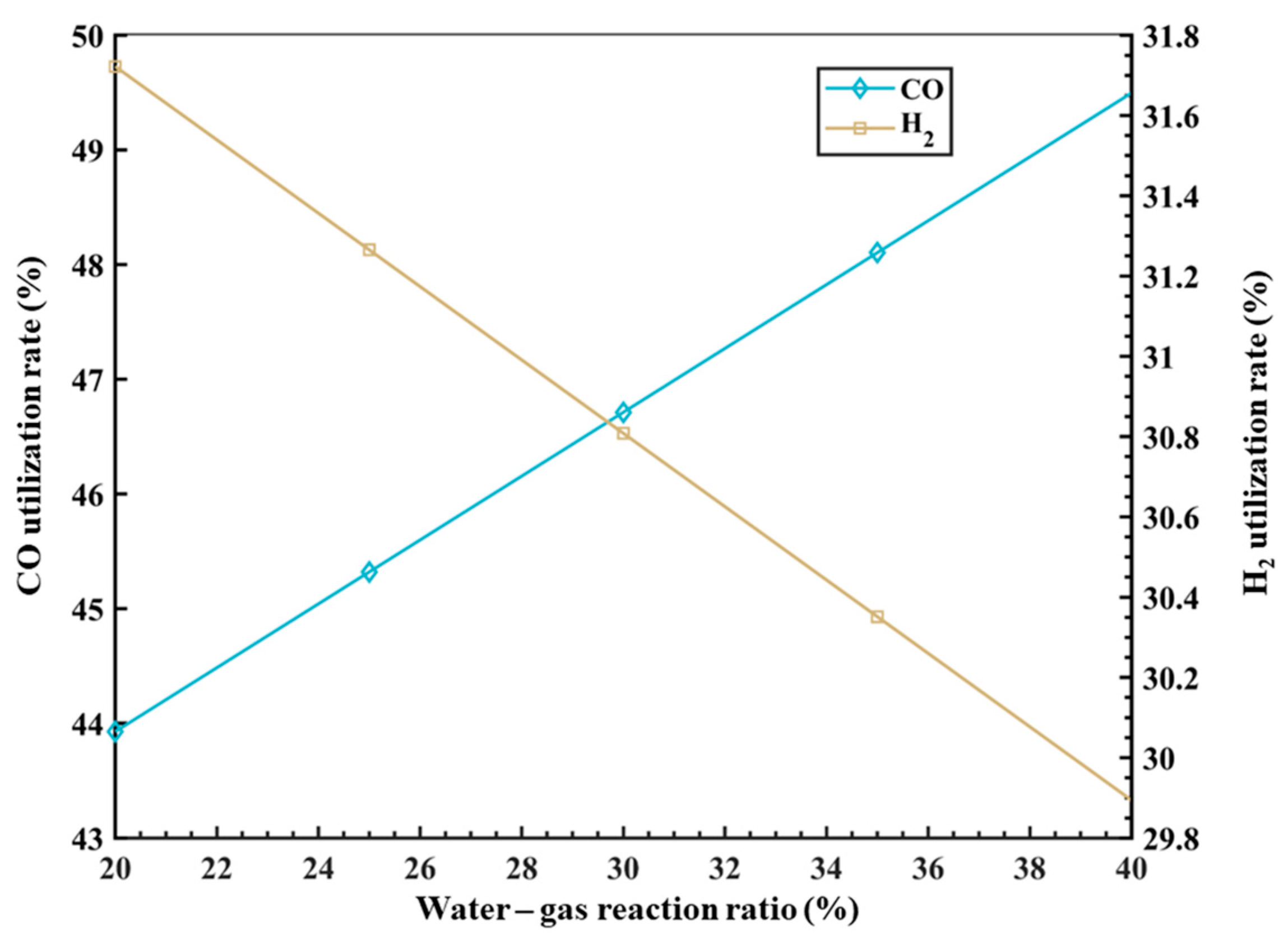Development of Mass–Energy Balance Model Based on a New Process of RSF with Hy-O-CR
Abstract
:1. Introduction
2. Model of RSF with Hy-O-CR
2.1. Boundary Conditions of RSF with Hy-O-CR Model
- (1)
- Within the RSF, a gas temperature of 1000 °C is used as the boundary between the upper and lower zone, which are divided into the upper low-temperature reduction zone and the lower high-temperature smelting zone, assuming that the boundary temperature for the solid burden entering the lower high-temperature zone is 950 °C, and the boundary temperature for gas entering the upper low-temperature zone is 1000 °C.
- (2)
- Sulfur in the RSF goes into the top gas, hot metal, and slag. The distribution ratio of sulfur in the top gas (ωs_top) is 5% [30], the content of sulfur in the hot metal is 0.025%, and the others enter the slag.
- (3)
- The methane production ratio (φCH4) is 1% of the total carbon consumption in the lower zone [31].
- (4)
- The temperature of the hot metal and slag are set to 1500 °C and 1550 °C, respectively.
- (5)
- (6)
- According to the operation experience of the shaft furnace, the reduction potential (E) of the top gas is not less than 1.22 [32].
2.2. Mass Balance
2.2.1. Mass of Iron Ore Consumption
2.2.2. Mass of Flux Consumption
2.3. Energy Balance
2.3.1. Calculation of Coke Ratio
2.3.2. Calculation of Reducing Gas Volume
2.4. Calculation Flow Chart of the RSF Model
3. Model of Top Gas Recycling
3.1. Boundary Conditions of Top Gas Recycling Model
- (1)
- The heat loss of the top gas is neglected when it is cleaned and recycled.
- (2)
- The dedusting rate of the dust collator is set at 100%, and the dewatering rate of the dryer is set at 100%.
- (3)
- The adsorption rate of CO2 separator is 95%, and it has no effect on the adsorption of other gas components.
- (4)
- The heat exchange rate of the heat exchanger is set at 60%.
3.2. Calculation of the Top Gas Recycling Model
4. Results and Discussion
4.1. Effect of Decarbonization Reducing Gas on Process Energy Consumption and Carbon Emissions
4.2. Effect of MR on Decarbonization Reduction Gas and Coke Ratio
4.3. Effect of Water–Gas Reaction Ratio on Gas Utilization Ratio
4.4. Analysis of Carbon–Hydrogen Footprints
5. Conclusions
- The reduction gas injected into the RSF shaft contains a certain proportion of hydrogen. Due to the endothermic reaction of hydrogen reduction of the iron oxides, the thermal balance distribution in the existing BF is disrupted. The new process requires additional heat input to compensate for the heat deficiency during the reduction process. This is achieved by supplying high-temperature reducing gas through the top gas recycling injection in the upper zone and reducing the direct reduction heat in the lower zone (promoting upward heat transfer of high-temperature gas). In the case of a high proportion of hydrogen, calculations and analyses using a thermal balance model in the lower-temperature upper zone and the higher-temperature lower zone confirm that the process can still achieve a balanced process in both the upper and lower zones when the distribution ratio of direct and indirect reduction is changed.
- Under the set constraints, as the CO ratio of the injected reducing gas increases, the total energy consumption of the process shows an upward trend. However, due to the use of top gas recycling heating technology in this process, the operating parameters can be optimized with the goal of achieving 100% utilization of recycled gas. Surplus or insufficient recycled gas will cause waste of resources or increased energy consumption. Therefore, the optimal solution is based on operating conditions obtained from 100% recycling of the top gas.
- Compared to traditional BFs, the new process achieves a significant reduction in CO2 emissions through a high proportion of hydrogen and CCUS technology. Without CCUS technology, the minimum CO2 emissions throughout the process can reach 660.73 kg/tHM, resulting in a 52.81% reduction compared to traditional BFs. With the implementation of CCUS technology, the direct CO2 emissions of the process can be reduced to 179.12 kg/tHM, resulting in an impressive 87.21% reduction compared to traditional BFs.
Author Contributions
Funding
Data Availability Statement
Conflicts of Interest
Nomenclature
| BF | Blast furnace |
| tHM | Tonne of hot metal |
| HM | Hot metal |
| tuy | Tuyere |
| MR | Metallization ratio, 85–95, % |
| more | The mass of ore consumption, kg/tHM |
| mcoke | The mass of coke consumption, kg/tHM |
| mslag | The mass of slag production, kg/tHM |
| mHM | The mass of hot metal, 1000 kg |
| mflux | The mass of flux consumption, kg/tHM |
| mdust | The mass of dust production, kg/tHM |
| mi_j | Mass of i in j, mi_j= mdust × ωi_j, kg/tHM |
| ωi_j | Mass fraction of i in j; I is the composition from Table 1 to Table 4, j is ore, coke, slag, HM, flux, and dust, % |
| qDRI | Calorific value of ore at 950 °C, MJ/kg |
| qcoke | Calorific value of coke at 950 °C, MJ/kg |
| qCO | Calorific value of CO at Ttop_gas, MJ/Nm3 |
| qCO2 | Calorific value of CO2 at Ttop_gas, MJ/Nm3 |
| Qi | The heat released by reaction of CO_Fe2O3, H2_Fe2O3, CO_FeO, C_O2, H2O_CO, H2_O2 and CO_O2, MJ |
| R2 | Binary basicity, R2 = 1.15 |
| Ttop_gas | Temperature of top gas, 150–250 °C |
| Tredu | Temperature of reducing gas, 800–950 °C |
| φCO_redu | Proportion of CO in reducing gas, 10–50% |
| φwater_gas | Proportion of water–gas reaction, 10–50% |
| φCH4 | Proportion of CH4, 1% |
| φco_redu | Proportion of CO in reducing gas |
| Hburn_tuy | The amount of heat burned in the tuyere, MJ |
| VCO_top | Volume of CO in furnace top gas, Nm3 |
| VH2_top | Volume of H2 in furnace top gas, Nm3 |
| VCO2_top | Volume of CO2 in furnace top gas, Nm3 |
| VH2O_top | Volume of H2O in furnace top gas, Nm3 |
| Vi_redu | Volume of components in reducing gas; I = CO, H2, CO2, and H2O, Nm3 |
| Qmaterial | The heat of material, including coke, DRI, HM, slag, gas_low, redu_low, gas_up, in_low, out_low, MJ |
| Qloss_low | The loss of heat, 400 MJ |
| qH2 | Calorific value of H2 at Ttop_gas, MJ/Nm3 |
| qH2O | Calorific value of H2O at Ttop_gas, MJ/Nm3 |
| Qj | The heat absorbed by reaction of C_O2, H2_FeO, CO_Fe3O4, H2_Fe3O4, CaCO3, and MgCO3, MJ |
References
- Wang, C.; Zhang, Y.X. Implementation Pathway and Policy System of Carbon Neutrality Vision. Chin. J. Environ. Manag. 2020, 12, 58–64. (In Chinese) [Google Scholar] [CrossRef] [PubMed]
- Shangguan, F.Q.; Zhou, J.C.; Wang, H.F.; Li, X.P. Climate change and decarbonization development of steel industry. Iron Steel. 2021, 56, 1–6. (In Chinese) [Google Scholar]
- Zhu, Q.S. Development pathway analyses for various ironmaking routes with ultra-low CO2 emission. Chem. Ind. Eng. Prog. 2022, 41, 1391–1398. (In Chinese) [Google Scholar]
- Kaoru, N.; Hiroshi, S.; Yutaka, U.; Kazumoto, K.; Koki, N.; Kohei, S.; Yoshinori, M.; Hirokazu, Y. Development of Low Carbon Blast Furnace Operation Technology by using Experimental Blast Furnace. ISIJ Int. 2022, 62, 2424–2432. [Google Scholar]
- Energy Transitions Commission. China 2050: A Fully Developed Rich Zero-Carbon Economy; Energy Transitions Commission: Beijing, China, 2019. [Google Scholar]
- Wang, P.; Ryberg, M.; Yang, Y.; Feng, K.S.; Sami, K.; Michael, H.; Chen, W.Q. Efficiency stagnation in global steel production urges joint supply-and demand-side mitigation efforts. Nat. Commun. 2021, 12, 2066. [Google Scholar] [CrossRef]
- Chikashi, K.; Yoshinori, M.; Hirokazu, Y.; Kohei, S.; Kazumoto, K.; Hiroshi, S.; Kaoru, N.; Yutaka, U.; Koki, N. Influence of Large Amount of Hydrogen Containing Gaseous Reductant Injection on Carbon Consumption and Operation Conditions of Blast Furnace—Development of Low Carbon Blast Furnace Operation Technology by using Experimental Blast Furnace: Part II. ISIJ Int. 2022, 62, 2433–2441. [Google Scholar]
- Quader, M.A.; Ahmed, S.; Dawal, S.Z.; Nukman, Y. Present needs, recent progress and future trends of energy-efficient Ultra-Low Carbon Dioxide (CO2) Steelmaking (ULCOS) program. Renew. Sustain. Energy Rev. 2016, 55, 537–549. [Google Scholar] [CrossRef]
- Li, J.; Kuang, S.; Jiao, L.; Liu, L.; Zou, R.; Yu, A. Numerical modeling and analysis of hydrogen blast furnace ironmaking process. Fuel 2022, 323, 124368. [Google Scholar] [CrossRef]
- Yin, R.Y.; Liu, Z.D.; Shangguan, F.Q. Thoughts on the Implementation path to a carbon peak and carbon neutrality in China’s steel industry. Engineering 2021, 7, 1680–1683. [Google Scholar] [CrossRef]
- Zhang, W.; Dai, J.; Li, C.Z.; Yu, X.B.; Xue, Z.L.; Saxén, H. A Review on Explorations of the Oxygen Blast Furnace Process. Steel Res. Int. 2021, 92, 2000326. [Google Scholar] [CrossRef]
- Shahabuddin, M.; Brooks, G.; Rhamdhani, M.A. Decarbonisation and hydrogen integration of steel industries: Recent development, challenges and technoeconomic analysis. J. Clean. Prod. 2023, 395, 136391. [Google Scholar] [CrossRef]
- Yu, Y.; Wang, X.D.; Luo, Z.G. Low-Carbon Ironmaking System and Method in Reduction and Smelting Furnace with Pure Oxygen and Hydrogen-Rich. China Patent ZL 200210084753.X, 31 January 2023. (In Chinese). [Google Scholar]
- Li, H.F.; Chen, J.R. An Analysis of Long-Process Ironmaking in a Reduction Smelting Furnace with Hydrogen-Enriched Conditions. Metals 2023, 13, 1756. [Google Scholar] [CrossRef]
- Fink, F. Suspension smelting reduction–a new method of hot iron production. Steel Times 1996, 224, 398. [Google Scholar]
- Ohno, Y.; Hotta, H.; Matsuura, M.; Mitsufuji, H.; Satito, H. Development of oxygen blast furnace process with preheating gas injection into upper shaft. Tetsu-Hagane 1989, 75, 1278. [Google Scholar] [CrossRef] [PubMed]
- Van Der Stel, J.; Hattink, M.; Zeilstra, C.; Louwerse, G.; Hirsch, A.; Janhsen, U.; Sert, D.; Grant, M.; Delebecque, A.; Diez-Brea, P.; et al. ULCOS top gas recycling blast furnace process (ULCOS TGRBF). In Research Fund for Coal and Steel (EC), EUR; final report; European Commission: Luxembourg, 2014; p. 26414. [Google Scholar]
- Nie, H.; Yu, A.; Jiao, L.; Mao, X.; Xu, H.; Kuang, S. Numerical Investigation of Shaft Gas Injection Operation in Oxygen-Enriched Ironmaking Blast Furnace. Metall. Mater. Trans. B 2022, 53, 2712–2734. [Google Scholar] [CrossRef]
- Yu, X.; Hu, Z.; Shen, Y. Modeling of hydrogen shaft injection in ironmaking blast furnaces. Fuel 2021, 302, 121092. [Google Scholar] [CrossRef]
- Danloy, G.; Berthelemot, A.; Grant, M.; Borlée, J.; Sert, D.; van der Stel, J.; Jak, H.; Dimastromatteo, V.; Hallin, M.; Eklund, N.; et al. ULCOS-Pilot testing of the low-CO2 Blast Furnace process at the experimental BF in Luleå. Metall. Res. Technol. 2009, 106, 1–8. [Google Scholar] [CrossRef]
- Liu, J.Z. Fundamental Research on Shaft Gas and Cycle Gas Behaviors in Oxygen Blast Furnace; University of Science and Technology Beijing: Beijing, China, 2015. (In Chinese) [Google Scholar]
- Xia, Z.; Jiang, Z.; Zhang, X.; Li, Z.; Lu, Y.; He, Y.; Chen, J. The CO2 reduction potential for the oxygen blast furnace with CO2 capture and storage under hydrogen-enriched conditions. Int. J. Greenh. Gas Control 2022, 121, 103793. [Google Scholar] [CrossRef]
- Zhuo, Y.T.; Hu, Z.J.; Shen, Y.S. CFD study of hydrogen injection through tuyeres into ironmaking blast furnaces. Fuel 2021, 302, 120804. [Google Scholar] [CrossRef]
- Baniasadi, M.; Mauret, F.; Kinzel, K.P.; Philipp, B.; Baniasadi, M.; Castagnola, C.; Saxén, H.; Hojda, S.; Lin, P. Investigating hydrogenous gas injection into the blast shaft and tuyere. In Proceedings of the 8th ECIC (European Coke and Ironmaking Congress) & 9th ICSTI (International Conference on Science and Technology of Ironmaking), Bremen, Germany, 29 August–2 September 2022. [Google Scholar]
- Mapelli, C.; Dall’Osto, G.; Mombelli, D.; Barella, S.; Gruttadauria, A. Future Scenarios for Reducing Emissions and Consumption in the Italian Steelmaking Industry. Steel Res. Int. 2022, 93, 2100631. [Google Scholar]
- Foo, S.Y.; Cheng, C.K.; Nguyen, T.H.; Kennedy, E.M.; Dlugogorski, B.; Adesing, A.A. Carbon deposition and gasification kinetics of used lanthanide-promoted Co-Ni/Al2O3 catalysts from CH4 dry reforming. Catal. Commun. 2012, 26, 183–188. [Google Scholar] [CrossRef]
- Ras, K.D.; Vijver, R.V.; Galvita, V.V.; Marin, G.B.; Geem, K.M.V. Carbon capture and utilization in the steel industry: Challenges and opportunities for chemical engineering. Curr. Opin. Chem. Eng. 2019, 26, 81–87. [Google Scholar] [CrossRef]
- Shen, F.M.; Zhang, W.L.; Zhang, A.J.; Zheng, H.Y.; Ding, Z.M.; Li, J. Regulation of carbon deposition during preparation process of hydrogen-rich reducing gas by natural gas reforming—An application example of H-C-O system mass balance and chemical equilibrium diagram. Iron Steel 2023, 58, 9–16. (In Chinese) [Google Scholar]
- Liu, J.Z.; Xue, Q.G.; Zhang, S.Y.; She, X.F.; Wang, J.S. Carbon deposition reaction based on heating recycling gas of oxygen blast furnaces. Chin. J. Eng. 2014, 36, 592–596. (In Chinese) [Google Scholar]
- Zhang, W.G.; Zhang, Z.W.; Xu, R.S.; Zhang, J.L.; Ye, L.; Zhu, J.F. Effect of hydrogen-rich gas injection on smelting operation of blast furnace. J. Iron Steel Res. 2023, 35, 1065–1073. (In Chinese) [Google Scholar]
- Liu, S.; Liu, X.J.; Lyu, Q.; Zhang, X.S.; Qie, Y.N. Study on the Appropriate Production Parameters of a Gas-injection Blast Furnace. High Temp. Mater. Process. 2020, 39, 10–25. [Google Scholar]
- Qu, Y.X.; Zou, Z.S.; Xiao, Y.P. A Comprehensive Static Model for COREX Process. ISIJ Int. 2012, 52, 2186–2193. [Google Scholar] [CrossRef]
- Shao, L.; Xu, J.; Saxén, H.; Zou, Z.S. A numerical study on process intensification of hydrogen reduction of iron oxide pellets in a shaft furnace. Fuel 2023, 348, 128375. [Google Scholar] [CrossRef]
- Liu, X.C.; Shi, E.Z.; Zhao, Z.C.; Xu, J.C.; Tang, J.; Chu, M.S. Research on preparation of pellets with different metallization rates under hydrogen-based shaft furnace condition. Sinter. Pelleting 2022, 47, 58–64. (In Chinese) [Google Scholar]
- Bernasowski, M. Theoretical Study of the Hydrogen Influence on Iron Oxides Reduction at the Blast Furnace Process. Steel Res. Int. 2014, 85, 670–678. [Google Scholar] [CrossRef]
- Nogami, H.; Kashiwaya, Y.; Yamada, D. Simulation of Blast Furnace Operation with Intensive Hydrogen Injection. ISIJ Int. 2012, 52, 1523–1527. [Google Scholar] [CrossRef]
- Negri, E.D.; Alfano, O.M.; Chiovetta, M.G. Direct reduction of hematite in a moving-bed reactor. Analysis of the water gas shift reaction effects on the reactor behavior. Ind. Eng. Chem. Res. 1991, 30, 474–482. [Google Scholar] [CrossRef]
- Alamsari, B.; Torii, S.; Trianto, A.; Bindar, Y. Heat and mass transfer in reduction zone of sponge iron reactor. ISRN Mech. Eng. 2011, 2011, 324659. [Google Scholar] [CrossRef]
- Kemppainen, A.; Alatarvas, T.; Iljana, M.; Haapakangas, J.; Mattila, O.; Paananen, T.S.; Fabritius, T. Water-gas Shift Reaction in an Olivine Pellet Layer in the Upper Part of Blast Furnace Shaft. ISIJ Int. 2014, 54, 801–809. [Google Scholar] [CrossRef]






| Composition | TFe | FeO | CaO | MgO | SiO2 | Al2O3 | MnO | P2O5 | TiO2 |
|---|---|---|---|---|---|---|---|---|---|
| Sinter | 57.45 | 8.64 | 9.37 | 1.41 | 5.26 | 1.92 | 0.21 | 0.12 | 0.11 |
| Pellet | 67.30 | 0.52 | 0.32 | 0.69 | 2.40 | 0.47 | 0.09 | 0.03 | 0.26 |
| Lump | 62.80 | 0.38 | 0.10 | 0.90 | 3.48 | 1.58 | 0.07 | 0.13 | 0.06 |
| Composition | H2O | C(Fix) | Ash | Volatile | |||||||
|---|---|---|---|---|---|---|---|---|---|---|---|
| Fe2O3 | CaO | MgO | SiO2 | Al2O3 | H2 | CO2 | N2 | CH4 | |||
| Coke | 0.43 | 87.3 | 0.76 | 0.45 | 0.11 | 5.32 | 4.03 | 0.12 | 0.28 | 0.64 | 0.02 |
| Composition | TFe | CaO | MgO | SiO2 | Al2O3 | MnO | SO3 | P2O5 | CO2 |
|---|---|---|---|---|---|---|---|---|---|
| Dolomite | 0.14 | 30.54 | 20.06 | 3.52 | 0.22 | 0.26 | 0.02 | 0 | 46.06 |
| Limestone | 0 | 55.36 | 0.90 | 1.00 | 0.14 | 0 | 0.10 | 0 | 44.49 |
| Silica | 0 | 0.34 | 0.08 | 94.95 | 2.31 | 0 | 0.10 | 0.02 | 0.36 |
| Composition | Si | S |
|---|---|---|
| Mass fraction in hot metal, % | 0.5 | 0.025 |
| Chemical Reactions | ΔH | Chemical Reactions | ΔH |
|---|---|---|---|
| 3Fe2O3 + H2 = 2Fe3O4 + H2O | −2.07 | 3Fe2O3 + CO = 2Fe3O4 + CO2 | −43.23 |
| Fe3O4 + H2 = 3FeO + H2O | 60.45 | Fe3O4 + CO = 3FeO + CO2 | 19.29 |
| FeO+H2 = Fe + H2O | 30.23 | FeO + CO = Fe + CO2 | −10.93 |
| CaCO3 = CaO + CO2 | 178.87 | MgCO3 = MgO + CO2 | 116.94 |
| C + 1/2O2 = CO | −110.54 | H2O(l) = H2O(g) | 44.77 |
Disclaimer/Publisher’s Note: The statements, opinions and data contained in all publications are solely those of the individual author(s) and contributor(s) and not of MDPI and/or the editor(s). MDPI and/or the editor(s) disclaim responsibility for any injury to people or property resulting from any ideas, methods, instructions or products referred to in the content. |
© 2024 by the authors. Licensee MDPI, Basel, Switzerland. This article is an open access article distributed under the terms and conditions of the Creative Commons Attribution (CC BY) license (https://creativecommons.org/licenses/by/4.0/).
Share and Cite
Li, H.; Chen, J.; Luo, Z.; Wang, X. Development of Mass–Energy Balance Model Based on a New Process of RSF with Hy-O-CR. Metals 2024, 14, 127. https://doi.org/10.3390/met14010127
Li H, Chen J, Luo Z, Wang X. Development of Mass–Energy Balance Model Based on a New Process of RSF with Hy-O-CR. Metals. 2024; 14(1):127. https://doi.org/10.3390/met14010127
Chicago/Turabian StyleLi, Haifeng, Jingran Chen, Zhiguo Luo, and Xiaoai Wang. 2024. "Development of Mass–Energy Balance Model Based on a New Process of RSF with Hy-O-CR" Metals 14, no. 1: 127. https://doi.org/10.3390/met14010127
APA StyleLi, H., Chen, J., Luo, Z., & Wang, X. (2024). Development of Mass–Energy Balance Model Based on a New Process of RSF with Hy-O-CR. Metals, 14(1), 127. https://doi.org/10.3390/met14010127







